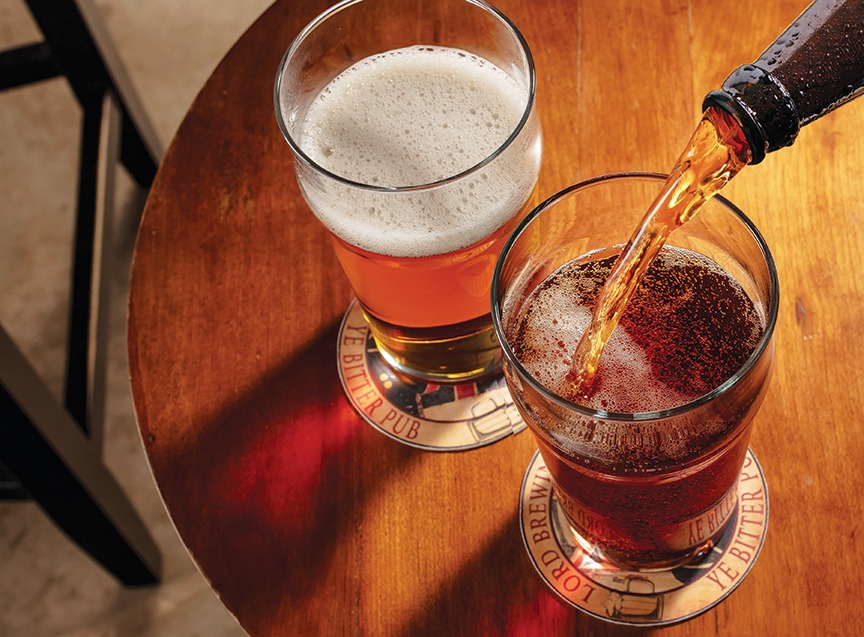Brewing Pilsner: Tips from the Pros
A good businessman knows the value of consulting experts. As investment bankers, Brock Wagner and Kevin Bartol already knew what a good company looked like. So before they opened Saint Arnold Brewing Co. in Houston in 1994, they made sure they knew what a good brewing company should look like. Homebrewing guru George Fix, another Texan, offered advice about brewing. Paul Shipman, the CEO who took the Redhook Ale Brewery public and sold part of it to Anheuser-Busch, provided help on the business side.
And microbreweries across the nation opened their doors when Bartol and Wagner showed up to visit their brewhouses. “Everybody was incredibly helpful, and we’ve tried to return that, helping people when they ask us for advice,” Wagner says.
While Bartol and Wagner have had limited use for mergers and acquisitions skills at the brewery — particularly in the early days, when overseeing distribution meant Bartol also drove a delivery truck and being in charge of brewing meant Wagner also mopped the floor — they did put their business training to immediate use.
“We’d had to go out and sell these companies,” Bartol says. “We’d seen so many businesses, so many that succeeded and so many that failed.” When they toured other microbreweries, they showed off the financial models they had come up with. “Most of them hadn’t done anything like that,” Bartol says. “We wouldn’t have thought about trying to sell a business without them.”
That may be one of the reasons why, while national sales of craft beer slowed to 5 percent in 1997, St. Arnold grew 26 percent on top of a 74 percent gain in 1996. And it accomplished this in Texas, where the battle for market share between Anheuser-Busch and Miller Brewing Co. is intense, and those brewing giants spend heavily on advertising.
“You can’t play in the big boys’ territory,” Wagner says, talking about flavor profiles and frequent pricing wars. “We sell ourselves on one thing, the taste of our beer.”
Wagner makes beer a homebrewer would be proud of. “Last year, we had homebrewers running around saying, ‘This is the best pilsner ever brewed,’” he says. “If you are doing this just because you want to make money, your beer has no soul.”
Making money is part of the St. Arnold plan, but Wagner says that, these days, he might make 25 percent of what he did as an investment banker. The brewery occupies 18,000 square feet in an industrial park with room to produce 20,000 barrels per year with additional fermenters. Right now, there are six fermenters, and two more are on the way. On days when Wagner, Dave Fougeron, and Pete Nordloh brew, they make two batches in a 30-barrel kettle, filling a 60-barrel fermenter.
Each fermenter is named for a different saint and, of course, the brewery is named after the patron saint of brewers. “For a while, we thought we had the curse of St. Arnold,” Wagner says, because the brew kettle blew up, then the man putting together the bottling line died. About that time, beer writer Michael Jackson visited and told the partners they needed to post a picture of St. Arnold in the brewery. They did, and things have run smoothly since.
The brewery even calls its house yeast “St. Arnold.” Wagner tried scores of yeast before finding this one in a yeast bank. You could still order the yeast from the same bank, if you knew what to order. “I share everything (about recipes) but the yeast,” Wagner says, smiling.
The flagship St. Arnold Amber Ale, which accounts for nearly 50 percent of sales, shows off the light fruitiness of the yeast perfectly. It is a deceivingly strong beer (original gravity 1.054, 5.5 percent alcohol by volume) made with two-row and Belgian cara-vienne malts. The amber is hopped at the beginning and in the middle with Cascade hops and at the finish with Liberty, and has 31 IBUs.
St. Arnold sells a small portion of its Amber Ale as “real ale,” putting it in firkins for a half-dozen bars in Houston, Austin, and the Dallas-Fort Worth area to serve via handpump. “I started doing it because I wanted to drink it,” Wagner says. He pulls the beer for real ale from the fermenter near the end of fermentation and racks it into casks, then dry hops it. Since no place in the brewery is exactly cellar temperature, the casks sit out for a day, then go into the cold box. (“St. Arnold” yeast continues to ferment at 50° F.)
By the time the beer leaves the brewery, it’s pretty well conditioned, and bar owners need only to insert a soft spile and hook up the firkin to a handpump. The bars move a cask in three to five days.
Wagner notes that the process is “pretty much what homebrewers do all the time.” To make and serve real ale at home, he suggests: Get the beer off most of the yeast. Move it over when most of the fermentation is complete. Prime it a bit. Dry hop it. (St. Arnold uses Liberty plugs for dry hopping.) Have a bunch of friends over and drink it quickly. Serve it through a beer engine with a sparkler, if possible. “That really makes a difference,” he says. “The sparkler brings out the aromas.”
St. Arnold Brown Ale and St. Arnold Kristall Weizen are the other two year-round beers. The brown ale — 1.053 OG, 24 IBUs, and made with five malts — is an English-style brown with just enough hops to balance the malt. “We use a very, very tiny amount of chocolate malt, but it goes a long way,” Wagner says. Kristall Weizen — 1.049 OG, 18 IBUs — is made with about 40 percent malted wheat. It has a palate-coating creaminess, with a hoppiness that cleanses the palate in the finish.
The brewery has done particularly well with seasonal beers. Wagner first brewed St. Arnold Christmas Ale in 1995, making a 30-barrel batch for draft customers. That lasted less than a week, so in 1996 he brewed 300 barrels for kegs and bottles. That was sold out by December 1. Last year he doubled the batch, and it lasted until Christmas.
St. Arnold Summerfest, the Bohemian-style pilsner, was particularly challenging. “One malt, two hops, but a tough beer,” Wagner says. Summerfest starts at 1.050. It is hopped with Czech Saaz and Tettnanger and has 41 IBUs. St. Arnold himself looks particularly different on the tie-dyed Summerfest label, where he is surrounded by palm leaves and sports sunglasses.
St. Arnold beers are loosely filtered and not pasteurized, so Bartol and Wagner chose a distributor who agreed to keep the beer cold and pull six-packs that are older than 90 days. “Typically, on the shelves you find (St. Arnold) beer that is one to three weeks old,” Bartol says. Still, the partners pull bottles from every batch, keep them at room temperature in the lab, and subject them to fluorescent lighting to see how they are standing up.
Tips on Brewing Pilsner
“It’s a simple recipe,” Wagner says of the pilsner, “but it took more recipes and more test brews than any of our other beers.
“The key is finding the right malt,” he says. Because there are no specialty malts used, the pilsner malt is responsible for providing the malt character. “The rich, big malt flavor is difficult to attain with no specialty grains.”
The challenge is to preserve the simple, clean, delicate flavor of the pilsner malt. There also is a certain depth, according to Wagner, that is characteristic of a pilsner malt and should come through in the beer.
For the Summerfest, Wagner uses Durst malt, which is more difficult to work with because it has a different consistency than the other grains he uses. When milled, it tends to powder instead of cracking. It is worth the trouble, though, he says. “You can make a good pilsner using two-row, but to make a great, true pilsner, you have to use good malt.”
Wagner recommends an imported German or Czech malt. You may have to do some searching to find one, but to him the results make it worth the effort. Choosing good malt may be the most important thing you can do to improve your pilsner, but it’s not the only thing. Like most styles, pitching rate and fermentation temperature are critical in creating a pilsner. Through his experience as a competition judge, Wagner has found the most common flaws are underpitching yeast and fermenting too warm.
Because pilsners are lagers, controlling temperature is very important when brewing them. At St. Arnold the lagers ferment at 52° F, which is typical of most breweries, he says. There are some larger commercial breweries that will ferment lagers at 57° F to speed the process, but Wagner recommends 52° F.
He suggests investing in an old refrigerator for lagering unless you are lucky enough to live in a place where you have access to a cellar that is a consistent 50° F. Even if you brew primarily ales, Wagner recommends a fermenting refrigerator with an external thermometer to avoid fermenting at too high a temperature, which is a common mistake for both ales and lagers. Set the temperature at 50° F to maintain a beer temperature of 52° F. This compensates for the heat given off by fermentation.
The other critical factor in making a pilsner is pitching adequate yeast. “Overpitching is possible,” he says, “but is much more difficult than underpitching. If you underpitch, it could have a very detrimental effect.” He recommends using two packages or doubling the recommended starter for a five-gallon batch.
A good pitching rate promotes a healthier, faster fermentation with less ester production and less chance of diacetyl, which is often a concern when making a lager. By reducing the lag time there is less chance of contamination as well. After pitching, Wagner aerates the pilsner by blowing sterile air through the 50° F wort. “You can’t really overaerate at this point,” he says. He recommends that homebrewers aerate after the wort drops below 100° F.



